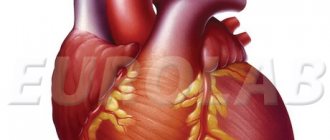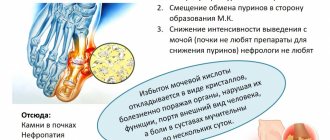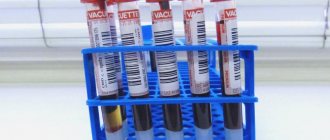Biochemist T. Tomiyama first isolated the nutrient from bovine liver. A year later, the American scientist E. Krebs synthesized it from apricot seeds. Later, biochemists found that vitamin B15 is widespread in nature: it is found in plant seeds. This determined the name of the substance, which arose as a result of the combination of two Greek words: “pan” - everywhere and “gamy” - seed.
The international name of the compound is Calcii pangamas.
Vitamin B15, like orotic acid (B13), belongs to the group of vitamin-like substances. These compounds are at the stage of detailed study.
Biological role of vitamin B15
The functions of vitamin B15 make it a very valuable component for maintaining human health. Pangamic acid:
• Prevents excess accumulation of fat in the liver, prevents the development of diseases of this organ.
• Reduces a person’s tendency to become overweight • Participates in the formation of DNA and RNA, that is, the genetic material of cells • Important for the renewal of tissues, cells and their individual components • Participates in the production of phospholipids that protect blood vessels from atherosclerosis • Reduces the content of bad cholesterol in the blood • Participates in redox reactions, improves tissue respiration • Enhances the production of various adrenal hormones • Increases performance and endurance, relieves fatigue • Helps cleanse the body • Improves heart function • Strengthens the immune system • Reduces the harmful effects of drugs on the body • Exhibits some anabolic effect, promotes muscle growth with regular exercise • Has an anti-inflammatory effect • Helps normalize blood pressure.
Instructions for using pangamic acid
Indications for use of the compound:
- vascular atherosclerosis;
- emphysema (pathological expansion of the air space in the bronchi);
- coronary insufficiency;
- bronchial asthma;
- obliterating endarteritis of the lower extremities;
- pneumonia;
- chronic hepatitis;
- syphilitic aortitis;
- itchy dermatoses;
- pneumosclerosis;
- various lesions of the cerebral arteries;
- rheumatism;
- cirrhosis of the liver;
- intense sports activities;
- alcohol and drug intoxication.
Along with this, the vitamin is used to improve the tolerability of corticosteroids, sulfonamides and anti-tuberculosis drugs.
Contraindications: glaucoma, arterial hypertension (severe forms).
Today, scientists have not established the daily preventive norm of pangamic acid that a person should consume daily. According to the literature, it is 1-2 milligrams per day. At the same time, for the treatment of certain diseases (rheumatism, vascular atherosclerosis, hepatitis, cirrhosis of the liver), the therapeutic dose of the drug increases to 50 - 200 milligrams.
The need for the nutrient also increases during intense sports, since normal muscle function (muscle performance) requires an increased amount of oxygen in the tissues.
Signs of vitamin B15 deficiency
Since small doses of vitamin B15 are produced in the body, it is rare to see a deficiency of pangamic acid. However, it is possible. Most often, a deficiency state manifests itself with nonspecific symptoms, which people for months and years attribute to fatigue, overwork, age and a general weakened level of health. Among the main symptoms of deficiency are a feeling of fatigue, cardiac problems, poor skin condition, early appearance of signs of aging, bad mood, irritability, and disturbances in hormone production.
Medicinal uses of pangamic acid
Vitamin B15 is extremely rare in its pure form, since it quickly oxidizes under the influence of oxygen and ultraviolet radiation. Therefore, in medical practice, calcium or sodium salts of pangamic acid (calcium or sodium pangamate) are used, which stimulate the endocrine glands (pituitary and adrenal glands), activate enzymatic transmethylation reactions, enhance the antioxidant defense of the body, increase the resistance of the body, in particular the myocardium, to oxygen. starvation." However, the clinical use of the vitamin compound for the treatment of gastrointestinal, nervous, cardiovascular, and musculoskeletal diseases is still being studied.
Let's consider in what cases calcium pangamate is used:
- Liver diseases. Vitamin B15, as part of complex therapy, helps increase the concentration of albumin in the blood, reduces the number of globulins to normal, thereby improving the albumin-globulin ratio. Along with this, the nutrient increases the level of creatinine in urine and blood, enhances diuresis and improves the patient’s well-being. Calcium pangamate is used for liver cirrhosis, chronic hepatitis, congestion due to alcoholism or circulatory disorders. The therapeutic dosage for intramuscular administration is 20 milligrams 2 times a day, for oral administration - 40 milligrams per day.
- Pathologies of the heart and blood vessels. Medicines containing pangamic acid are used to alleviate post-infarction and pre-infarction conditions. After administration of the compound, the enzymes of the respiratory chain are activated, creatine biosynthesis is enhanced, which is accompanied by an improvement in myocardial trophism. Pangamic acid is used to treat atherosclerosis, hypertensive heart disease, angina pectoris, coronary insufficiency (due to lipotropic and vasodilating properties). The daily dosage is selected by the doctor depending on the patient’s condition and the severity of the pathology (from 30 to 100 milligrams per day).
- Neurological disorders. Pangamic acid is prescribed as part of the complex treatment of cognitive disorders, hysteria, seizures, epilepsy, hydrocephalus, cerebral palsy, bedwetting in children, depressive states and psycho-emotional overload. In the “presence” of calcium pangamate, an element of group B (the hormone of happiness) is synthesized - choline, which is involved in the myelination of nerve fibers and strengthening the membranes of brain cells. Considering the fact that vitamin B15 improves tissue respiration and the transmission of impulses to neurons, it is successfully used in medical practice to combat sclerosis. This is evidenced by numerous studies by Dr. Benati. Thus, the scientist’s experiment involved patients suffering from hemiplegia and other pathologies of the central nervous system. During the experiment, patients were administered 25 milligrams of calcium pangamate per day (intramuscularly). At the end of the experiment, Benati testified that the patients had increased emotional status, decreased speech disorder and improved health.
- Diseases of the musculoskeletal system. Due to the fact that vitamin B15 reduces the irritating effect of salicylic sodium on the adrenal cortex and enhances the pharmacological properties of cortisone and acetylcholine, the compound is used as part of the complex treatment of rheumatoid arthritis.
- Elimination of intoxication. Considering the fact that calcium pangamate has antitoxic properties, the drug is used for acute poisoning with alcohol, drugs, tetracycline antibiotics, and chlorine-containing organic compounds. As a result of research, scientists noted that daily intake of vitamin B15 reduces the craving for drinking alcohol and drugs.
The therapeutic dose of calcium pangamate varies from 50 to 150 milligrams per day. The course of treatment is 18–40 days. If necessary, therapy can be repeated after 3 months.
Sources of income
Some scientists argue that part of the amount we need is produced by our intestinal microflora. However, this fact has not yet been reliably confirmed. But food sources of this compound have long been known.
Contents vit. B15 per 100 g of food:
| Product | Content, mg/100 g |
| Beef liver | 0,1 |
| Pork liver | 0,09 |
| Apricot kernels | 0,16 |
| Wild rice | 0,06 |
| Rice bran | 0,057 |
| Nuts | 0,14 |
| Watermelon | 0,07 |
| Brewer's yeast | 0,05 |
| Plants' seeds | 0,2 |
Pangamic acid is present in many other foods of plant and animal origin. It should be taken into account that thermal cooking leads to significant destruction of vit. B15.
Daily requirement
The daily amount of Vit we need. B15 directly depends on age.
| Category | Daily requirement, mg |
| Preschool children | 40 |
| Schoolchildren | 80 |
| Teenagers | 140 |
| Adults | 290 |
Minimum quantities are shown here. In extreme conditions, during physical activity and illness, the need for vitamin B15 increases many times over.
General information and history of discovery
Pangamic acid (lat. Acidum pangamicum) in its pure form is an extremely unstable substance, therefore it is used only in the form of a salt - calcium pangamate (lat. Calcii pangamas).
The chemical formula of vitamin B 15 is C10H19NO8.
Systematic name: 6-(2-dimethylamino-acetoxy)-2,3,4,5-tetrahydroxy-hexanoic acid. The compound is an ester of dimethylglycine and gluconic acid.
The first discovery belongs to the Japanese scientist T. Tomiyama, who isolated the molecule from cow liver in 1950.
The name “pangamas”, derived from the Greek words “pan” - everywhere and “gami” - seed, was introduced into use after the presence of the substance in the bones and seeds of plants was established.
Interaction with other substances
Vit. B15 enhances the effect of vit. A, C, E, B12. Also promotes the synthesis of vit. AT 4. Vit. B17 and vit. B15 mutually enhance the oncoprotective effect of each other. Vit. B15 neutralizes the effects of many poisons, incl. chlorine-containing drugs, alcohol. It also reduces the negative effects of antibiotics, sulfonamides, and anti-inflammatory drugs.
Alcohol, nicotine, caffeine destroy it and help reduce its level in the blood plasma. Pangamic acid improves the absorption of anti-tuberculosis drugs and synthetic corticosteroids.
Release forms
Vitamin B15 (INN - calcium pangamate) is available in the form of tablets, as well as capsules in gelatin or vegetable shells. Absorption, assimilation and pharmacological effect are identical in all release forms.
The tablets are packaged in packs of 100 pieces and contain a mixture of pangamate, gluconate and calcium chloride in a ratio of 11:4:1, respectively.
Recipe in Latin:
Rp.: Calcii pangamatis 0.5
Dtd No. 100 in tabuletti
Signa: take 1-2 tablets 3 times a day.
Symptoms of hypovitaminosis
Clinical symptoms may be blurred or disguised as other diseases. Often people with signs of vitamin deficiency are seen by an endocrinologist, cardiologist, gastroenterologist or therapist. Patients complain about:
- increased fatigue;
- decreased performance;
- muscle weakness;
- irritability, depressed mood;
- numbness, tingling in the limbs;
- interruptions in heart function;
- dryness, flaking of the skin;
- fragility, hair loss.
It is extremely difficult to confirm hypovitaminosis from the clinical picture, so the diagnosis is usually made by exclusion, and therapy is selected empirically.
Physicochemical characteristics
Due to the lability of chemical bonds, studying the properties of pure pangamic acid is difficult: it is destroyed under the influence of ultraviolet rays and high temperatures, and dissolves in water.
To produce drugs that have an identical biological effect, calcium pangamate is used, the chemical formula of which is [ COO ~ - CHOH - CHOH - CHOH - CH0HCH2OCOCH2N(CH3)2 ] 2Ca2+ -H2O.
The substance is a white powder, insoluble in alcohol and organic solvents, having a melting point of 132-140°, stable in acidic environments and rapidly decomposing in alkaline environments.









